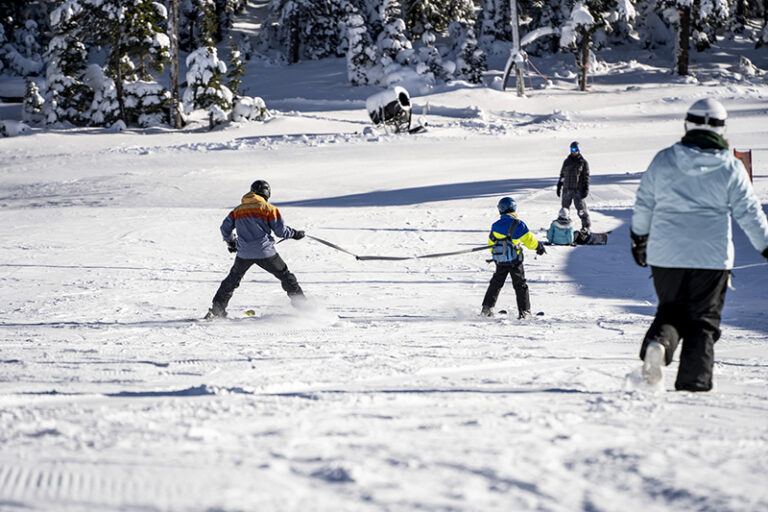If the cooler nights, fading morning light, and brilliant leaves aren’t enough, the hundreds of ski swap signs blanketed across Spokane is a sure sign that we are rapidly approaching winter.
If you’re one who looks forward to the snowy season, soon fall checklists will turn into pre-season ski rituals. Whether you annually tune your skis, follow the hundreds of large white signs to the ski swap, or start checking your snow report app in anticipation of a powder day, there’s one more thing you need to add to your list this year: ski conditioning. Physically preparing your body for the demands of such a dynamic sport is essential to maximizing your enjoyment on the slopes and minimizing your risk of injury.
When examining injury statistics, it’s apparent that there have been dramatic changes over the past 50 years as skiing and the equipment have evolved. Early alpinists suffered ankle sprains and tibia fractures from soft leather boots and bindings derived from crude cable technology with unreliable release mechanisms. Though advancements in equipment have led to a fall in the gross numbers of ski-related injuries, the rates of serious knee ligamentous injuries have actually increased. Some studies have found that skier ACL injury risk has now risen to a level comparable with that of collegiate football players. While ski shapes have more recently started to curb this trend, there are other strategies to keep you out of the operating room.
1) Learn how to fall
One of the factors most strongly related to ski injury is skier experience. Several studies have demonstrated that the least skilled and least experienced skiers are the most prone to injury. More experienced skiers are able to fall less frequently, and when they do fall, they do so in a less hazardous manner. Two recent studies demonstrated decreased incidence of ACL injuries through simple instruction of injury prevention techniques. The most basic technique was to fall with the knees flexed and avoid trying to get up while sliding (see figure 1. for one of the most common causes of ACL injury).
2) Don’t ski through fatigue
Fatigue is an unavoidable component in a full day of skiing. A large percentage of skiers take one or two ski vacations a year and try to cram the most into each day. Bodies aren’t accustomed to 6-8 hours of exercise, which can lead to fatigue and weakness. Most injuries happen at the end of the day due to the fading light and trying to ski through fatigue.
Pre-Season Ski Conditioning
A simple pre-season training program can be divided into building stamina, and strength and improving balance and flexibility. Here are some tips to get you started, but the best way to ensure you have a solid program that is enjoyable and trains you adequately is to enroll in a ski conditioning class like those offered by Physical Therapy Associates in Spokane (see sidebar). What better way to prepare than to sweat with a bunch of powder crazed carvaholics whose ski fitness levels have also fallen to sub-par.
- Build your stamina. Begin to strengthen your heart by exercising 3-4 times a week, working up to at least 30-45 minutes within 60-80 percent of your max heart rate (220-age) to maximize the benefit of exercise. Consider at least two means of exercise. Also, try specifying your cardiovascular program to your winter sport. For downhill skiing, incorporate interval training into your workouts.
- Build your muscular endurance. Choose exercises targeting your core and lower extremities, which will allow you to ski for a longer period of time safely. Inadequate strength affects ski technique and increases the risk of injury. With any strengthening program it’s important to work to a point of fatigue to maximize muscle growth.
- Improve your balance. This is vital when needing to change directions quickly on advanced terrain or recovering from a non-ideal position. Good skiers aren’t necessarily in the ideal position at all times, but they are able to continue to perform and return to a state of equilibrium. An applicable definition of balance on the slopes is a sequence of linked recoveries.
- Improve your flexibility. Recent studies have shown static stretching before sports is ineffective at reducing injury but that dynamic stretching or warm up does a better job of preparing for the demands of high level activity. Instead of holding that hamstring stretch for the duration of your first chair lift ride up the mountain, try a series of lunges.
Avoiding Injury
In addition to proper conditioning, here are some other suggestions to minimize injury risk on the slopes:
- Use equipment that is appropriate for your age, size and ability.
- Equipment must be well maintained and properly adjusted by a professional on an annual basis.
- Ski under control and within your limits. Stop skiing before fatigue compromises your ability to ski safely.
- Recognize that as surface conditions deteriorate, the slope or trail difficulty level goes up.
- Undertake a pre-season conditioning regimen incorporating strength, endurance, balance, and flexibility.
Sign Up for a Ski Conditioning Class
Physical Therapy Associates(2507 E 27th Ave, Spokane) offers ski conditioning classes on Monday and Thursday from 6-7 p.m. from November 4 to December 16.
The classes are high-energy with 10-15 circuit stations designed to simulate what your body will encounter on the slopes. For more information contact [email protected] or call 509-456-6917. Learn more about all the class they offer online at Ptassociates.net. // (Jonathan Hook)













